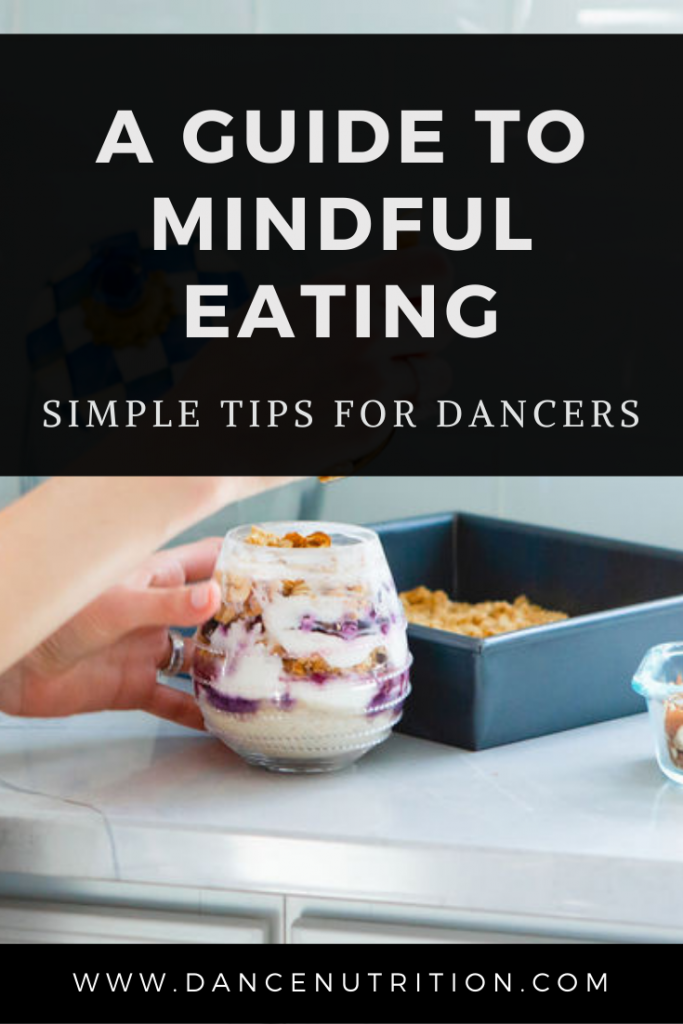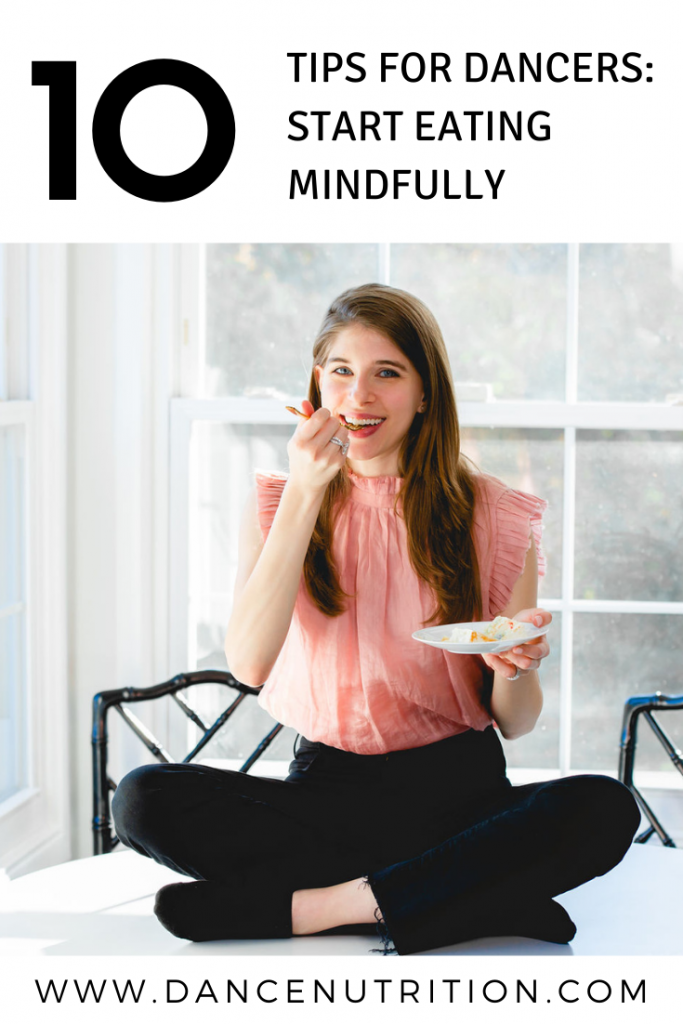Mindful eating is often described as the practice of paying close attention to your eating experience. When eating mindfully, you’re able to notice flavors, textures, and fullness cues while being present in the moment. For dancers, this can be a valuable tool for building awareness around meals and snacks.
But mindful eating is sometimes confused with intuitive eating or seen as an “end goal” on its own. While the two are related, they aren’t the same. Intuitive eating is a broader framework designed to help people rebuild trust in their bodies. Mindful eating, on the other hand, is one specific tool that can support the journey.
What Mindful Eating Is And Is Not
Mindful eating enhances awareness of the present moment around food, including sensations, environment, thoughts, and feelings. It helps you gather information so you can make clearer, kinder decisions in the moment. For example, if you’re midway into a meal and feeling content, mindfulness allows you to pause and say “I’ll save the rest for later.”
When used flexibly, mindful eating returns an underrated *nutrient* to your plate: satisfaction. This improves trust in internal hunger/fullness cues, reduces “out-of-control” episodes, and lowers meal-time stress.
But if used in a way that’s rigid, mealtime mindfulness can drive a preoccupation with food. To avoid this, you’ll want to remember that mindful eating is not:
- A shortcut for healing from diet culture (that work is intuitive eating and often needs professional support). You can learn more about it here.
- A 100%-of-the-time rule. Making mindful eating into a rigid requirement is just another food rule.
- A path to judgment. If mindful practices (or lack thereof) lead to more shame, they’re not helpful.
Most importantly, mindful eating is not an end goal. It’s just a tool that can help in the process of rebuilding your relationship with food.
When Can Mindful Eating Help Dancers?
Mindful eating works best when you have the time to access it. Unfortunately, busy schedules are common for dancers— mindless, on-the-go eating is a norm.
Under-fueling, such as from dieting or disordered eating, also makes this work challenging. A restrictive history— low calorie intake, viewing food as “good” and “bad,” fears of weight gain, and the desire to micromanage your food choices— drives you further from accessing mindfulness. In these instances, a proactive effort is first needed to alleviate food anxiety. If you often find yourself bingeing, emotionally eating, or hungry all the time, it can be worth working with a Registered Dietitian Nutritionist to first tackle underlying deprivation.
How Can Mindful Eating Benefit Dancers? 10 Tips To Eat Mindfully
Once your body is getting enough fuel and you’ve worked through some of the anxiety around food, mindful eating can become a powerful tool. It’s not about eating slowly or perfectly; it’s about experimenting with awareness in a way that feels supportive rather than stressful. Below are 10 approachable ways to practice mindful eating in your daily routine.
- Set intention (30 seconds). Tell yourself: “This is one practice meal. I’m here to notice, not to fix.”
- External scan (10–20 seconds). Where are you eating? Who’s around you? Is the space noisy or calm? These things change how you’ll eat.
- Internal check (10–20 seconds). How are you feeling right now — stressed, tired, relaxed? Try one deep breath to settle if you need it.
- Engage the senses (first bite). Notice aroma, color, temperature, and the first flavor note. Is it familiar? Surprising?
- Notice texture. Soft, crunchy, chewy — what do you like or dislike? Allow curiosity.
- Slow and taste (middle of the meal). Aim to put your utensil down between bites at least a few times so you can notice flavor and fullness changes.
- Three check-ins. Pause to assess fullness roughly at 25%, 50%, and 75% of what you’re eating. Use your Hunger–Fullness scale language to name it.
- Remove judgment. Notice any “should” or “shouldn’t” thoughts and let them pass like clouds. You have permission to eat this meal.
- Wait before the final judgment. Say ✋ hi-5 to yourself for practicing. Then give your body ~20 minutes after finishing before you decide whether you need more. Often, satisfaction clarifies with time.
- Journal one line. Was the meal satisfying? Energizing? Left you hungry? One sentence is enough — you’re building data, not criticism.
Quick Cues: Busy Rehearsal Days
Mindful eating doesn’t always mean a long, slow meal. Sometimes you’ll only have 5 minutes to eat in the hallway before rehearsal. In these moments, try one or two micro-practices:
- Check in before you rush in. Even one deep breath helps you notice if you’re eating out of true hunger, stress, or habit.
- Use a single sensory anchor. Pay attention to one quality of your food: the crunch of an apple, the creaminess of yogurt, the smell of peanut butter on toast.
- Give yourself permission. Remind yourself that a quick snack is fuel, not a “bad” meal.
- Pack smart. Having prepped snacks like trail mix, cheese sticks, or oat bars makes it easier to pause and notice satisfaction without distraction.
- Set a “mini-closing ritual.” Even if it’s just a sip of water or saying, “okay, back to rehearsal,” mark the moment so your brain registers that you’ve eaten.
Self-evaluation (5 Quick Questions)
Mindful eating is a tool to gather evidence. After the meal, jot answers to these prompts:
- Did I feel physically satisfied 20 minutes after finishing?
- Did I notice any strong emotions while eating?
- Did judgment or perfectionism show up?
- Was my portion choice guided by preference or by rules?
- What’s one small change I want to try next time?
If mindful eating left you feeling deprived, consider whether you’re ready for this tool now, or if you need support to address deprivation or food fears first. Assess whether your meal or snack was balanced. Make sure you’re honoring food preferences (rather than food rules). Here are two additional articles to help you discover opportunities for change.
Key Takeaways
Mindful eating is a skill, not a cure. Use it as a way to gather information, not as another rule. It works best when you’re adequately fueled and not in a survival response to restriction. But don’t aim to be perfectly mindful 100% of the time; choose the moments that matter.
If you work with me in The Healthy Dancer®, you’ll get a Food & Mood Journal to track these experiments and see patterns across your training week. Need help now? Book a session with a Registered Dietitian Nutritionist experienced with dancers to fuel for performance and learn to use mindful eating in a way that supports recovery, not restriction.




